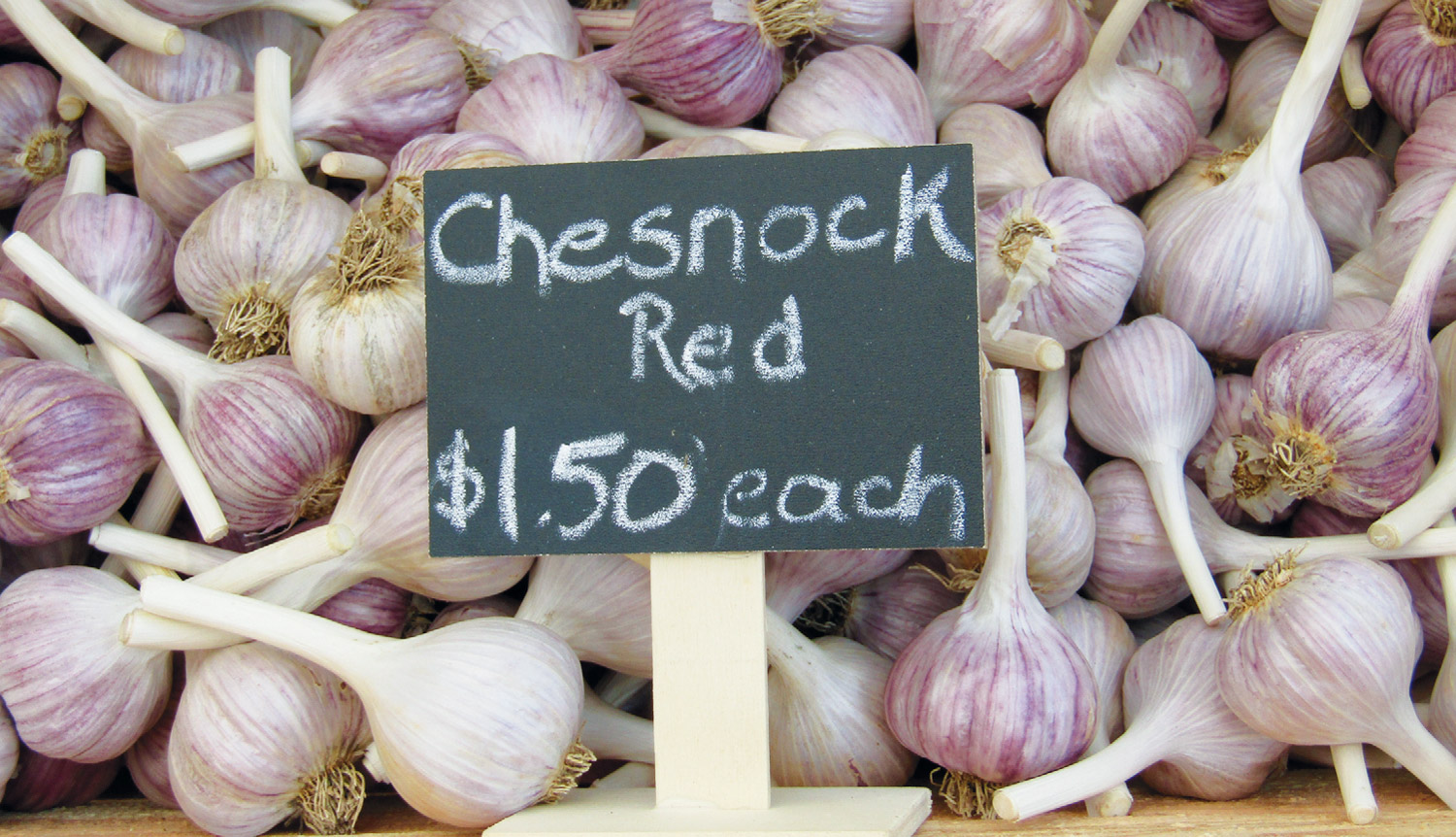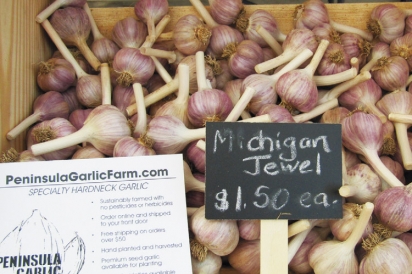Peninsula Garlic Farm
Peninsula Garlic Farm
If you seek a pleasant peninsula, look about you. And if it smells like garlic, you’re probably at the booth of Peninsula Garlic Farm. This winter, you’ll find three of their varieties of hardneck garlic at the Indoor Farmers’ Market in The Mercato in Traverse City. Pick some up, ask some questions and count yourself in on the ground floor of the next big culinary trend in Northern Michigan.
“Big picture, big dreams? Yes, we’d like to be the largest organic garlic farm in the state of Michigan,” says Kevin Gregory, owner. He and his wife, Tiffany, purchased 60 acres of farmland between Traverse City and Buckley in July of 2017—but because garlic is a two-year crop, their initial harvest came from a little further afield.
In Michigan, garlic is planted in the fall, so in 2016 the Gregorys leased one acre of farmland from Kevin’s father in Rodney, Michigan, just east of Big Rapids. That crop of 25,000 cloves was harvested in July and introduced at the Interlochen, Elk Rapids and Traverse City farmers’ markets in August for sale as both culinary and seed garlic.
“The reception has been great,” says Tiffany. “We had some people buying just one or two bulbs, but many purchased full bags and ordered seed from us as well. I answered lots of questions about how to plant and use garlic, but my favorite were all the people that asked, ‘Did YOU grow this?’ There is a lot of room for increased knowledge about garlic in this state.” And even though she doesn’t field too many vampire jokes, her past work as a phlebotomist (a person trained to draw blood) provides plenty of comedy fodder.
Garlic falls into two main categories: softneck and hardneck. Softneck garlic produces smaller bulbs and when harvested has a long flexible stem that works well for braiding the crop together. Hardneck garlic produces scapes (tall green shoots that curl and are an amazing conversation starter), has larger bulbs and a stem that stiffens after harvest. Hardneck garlic handles Michigan winters better and stores for a longer period of time.
Starting an organic garlic farm took careful planning and lots of research. Tiffany explained their thought process like this: “We knew we wanted to grow a nutrient-dense crop that promotes health and is sustainable. Plus, we also needed to make a profit from it. Garlic checks all of those boxes while allowing me to work around the schedule of having two small children. We feel like we are doing something meaningful—food and feeding people are important.”
Kevin is a fourth-generation farmer, although he works full-time as an engineer. His great-grandfather purchased land in Rodney directly from a lumber company and spent the next 10 years pulling out stumps with horses. As was common back then, he grew a little of everything. His son, Kevin’s grandfather, specialized in pickling cucumbers, which he sold directly to Heinz, and also grew asparagus. When Kevin’s parents took over the farm they switched to fresh market asparagus. Today they grow 50 acres of asparagus and are adding another 40 this year.
Like many children growing up on farms, Kevin saw his parents work off-farm and felt it was impractical to plan on full-time farming. “Farming can get expensive very quick. In the U.S., all development of mechanical cultivation stopped in the 1940s with the onset of sprays. In Europe, their mechanical farm machines are way ahead of ours. What that means is that small farms have to find other ways to get the job done,” explained Kevin.
One plan they have is to develop their own mechanical planter, using Kevin’s engineering know-how and implements popular in Europe. “Currently, there is no mechanical way to plant hard neck garlic, so we plant each and every clove by hand,” said Tiffany. “This year that will be roughly 50,000 cloves on one to two acres. Next year we’d like to have closer to eight acres in garlic.”
The planting process involves the tractor only for making the rows. The next step is a good old-fashioned work bee where people place each bulb root side down in the hole. The garlic goes through a chilling period over the winter and comes up in the spring. And that’s when the fun starts. Garlic leaves are thin and don’t shadow the ground. Which means weeds get plenty of sun and flourish. So the main occupation of the garlic farmer is to pull weeds. And pull weeds. And pull weeds.
Getting the farm ready for garlic planting in just three months took a lot of work. When they purchased the land in July, it was being used as horse pasture and a hay field, with 40 acres leased to a neighboring farmer for field corn. After getting soil samples, the Gregorys selected the best acres to start with and have been preparing it ever since. “The land was a little more acidic than ideal, so we’ve been adding organic enrichments such as composted chicken manure (6,000 pounds of it!), fish emulsion, seaweed, liquid crab concentrate, microbes, enzymes and more.”
Garlic needs to go into new fields every year and not be returned to the same spot for three to four years. The rotation plan is to grow a soil-building “green manure” crop one year, followed by an organic largescale crop such as carrots, beans or grain. Further plans for the property include planting a pollinator garden, adding beehives and tapping the maple trees.
Hardneck garlic produces two crops. The first are scapes—twisty stalks that erupt from the center of the clove in midsummer. These are cut off to increase clove size and taste. Scapes are a culinary delicacy often compared to fresh asparagus and can be used for many dishes, including stir-fry and pesto. The second crop is the actual cloves that are usually harvested in mid- July. These need to be pulled and then hung to cure. After they are fully dry, each clove gets trimmed and cleaned.
“Gardeners always comment on how clean our garlic is,” said Tiffany. “They ask what my trick is—and I tell them: After we remove the outside wrapper from the dried clove I scrub it with a toothbrush. It’s labor intensive, but makes a big difference for display.”
While Peninsula Garlic Farm is currently selling the culinary cloves at farm markets and their seed online, plans for the future include purchasing a peeler so more garlic can be sold to restaurants, creating a dried garlic powder and introducing black garlic to the Northern Michigan market. Black garlic originated in Asia and is created by a process of fermenting and heating garlic over a long time period. The result is a super food with a wonderfully complex flavor.
IF YOU GO:
Farmers’ Market at the Village at Grand Traverse Commons
Saturdays 10 AM–2 PM
In the Mercato at Building 50
830 Cottageview Dr., Traverse City
http://www.PeninsulaGarlicFarm.com, 231-598-0802
What to do with garlic?
If a recipe calls for onions, you should put garlic in too. In addition to the traditional uses, the Gregorys recommend trying their garlic in new ways:
• Eat it raw! Slice garlic very thin and mix with mayo on a ham sandwich or add to salads.
• Mix it in with ground beef to add a new taste dimension to your burgers.
• Roast it and add to salads, pasta and pizza.
• Chop the top off a full head and slowly saturate with olive oil then sprinkle with salt. Grill on high heat until soft and mushy—it will be easy to squeeze out each clove when done.







